Strategy and Case Analysis of the US Airline Industry
VerifiedAdded on 2020/05/16
|14
|3529
|258
Report
AI Summary
This report provides a comprehensive analysis of the US airline industry, examining its competitive landscape and profitability challenges. It begins with an overview of the industry, highlighting the dominance of major players like United, Delta, and American Airlines, as well as the impact of low-cost carriers and online travel agencies. The core of the analysis utilizes Porter's Five Forces model to assess the competitive intensity, bargaining power of buyers and suppliers, and the threats of new entrants and substitutes. The report discusses the advantages and disadvantages of the Porter's Five Forces model, and explores the cyclical nature of the US airline business, which is heavily influenced by economic conditions. Finally, the report recommends strategies for improving airline profitability, such as upselling services, enhancing the travel experience, and going beyond transporting passengers.
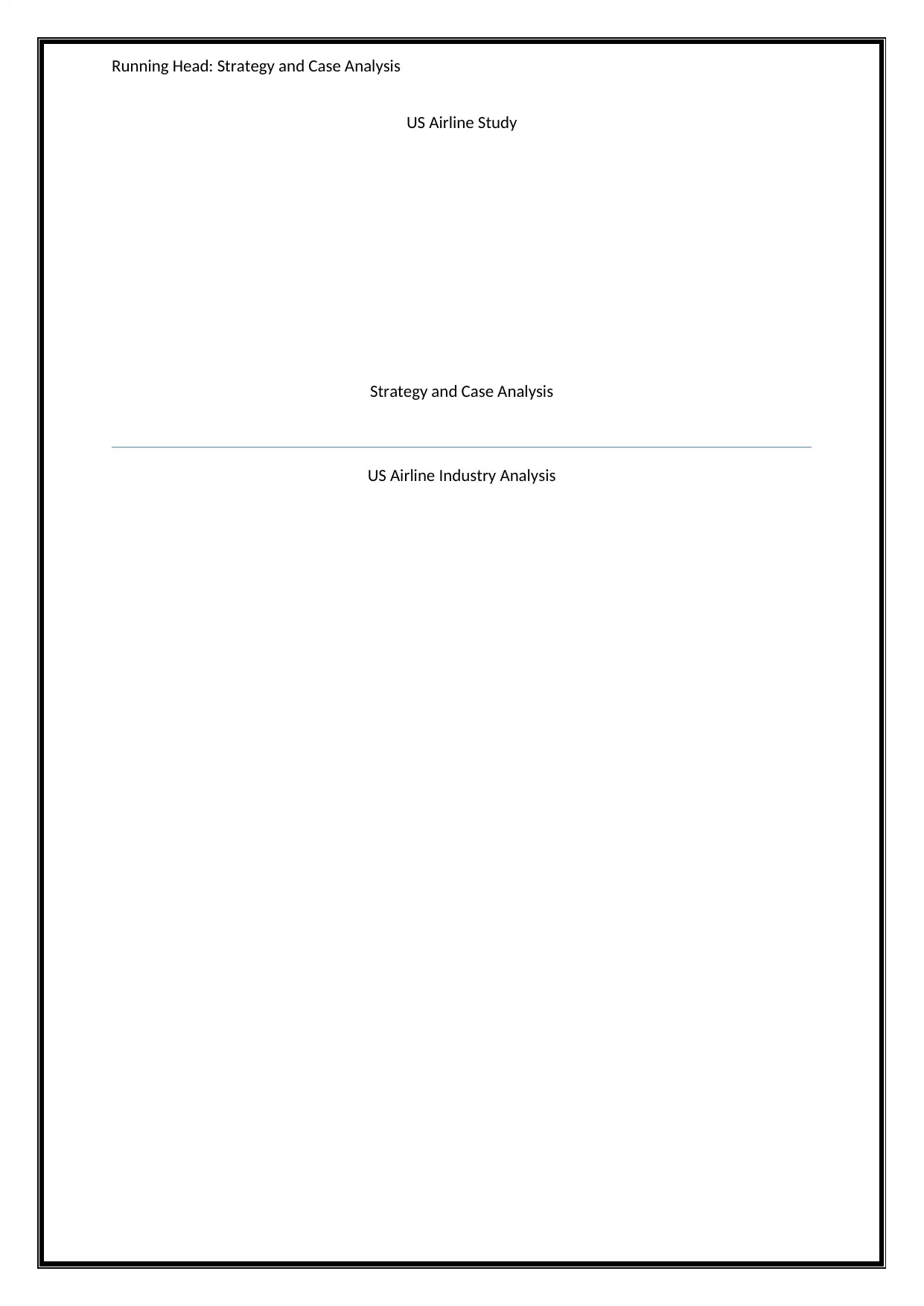
Running Head: Strategy and Case Analysis
US Airline Study
Strategy and Case Analysis
US Airline Industry Analysis
US Airline Study
Strategy and Case Analysis
US Airline Industry Analysis
Paraphrase This Document
Need a fresh take? Get an instant paraphrase of this document with our AI Paraphraser
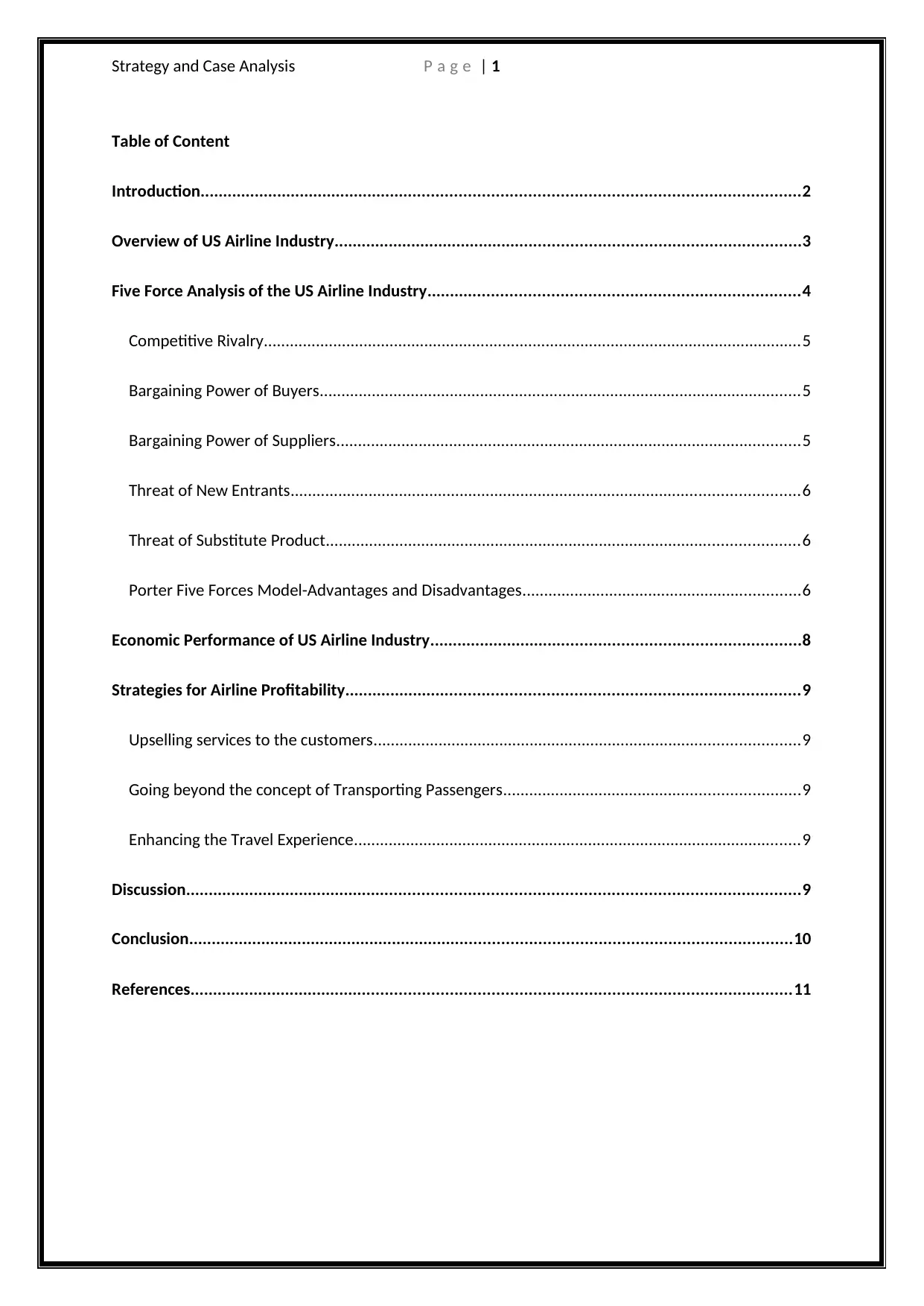
Strategy and Case Analysis P a g e | 1
Table of Content
Introduction...................................................................................................................................2
Overview of US Airline Industry......................................................................................................3
Five Force Analysis of the US Airline Industry.................................................................................4
Competitive Rivalry............................................................................................................................5
Bargaining Power of Buyers...............................................................................................................5
Bargaining Power of Suppliers...........................................................................................................5
Threat of New Entrants.....................................................................................................................6
Threat of Substitute Product.............................................................................................................6
Porter Five Forces Model-Advantages and Disadvantages................................................................6
Economic Performance of US Airline Industry.................................................................................8
Strategies for Airline Profitability...................................................................................................9
Upselling services to the customers..................................................................................................9
Going beyond the concept of Transporting Passengers....................................................................9
Enhancing the Travel Experience.......................................................................................................9
Discussion......................................................................................................................................9
Conclusion....................................................................................................................................10
References...................................................................................................................................11
Table of Content
Introduction...................................................................................................................................2
Overview of US Airline Industry......................................................................................................3
Five Force Analysis of the US Airline Industry.................................................................................4
Competitive Rivalry............................................................................................................................5
Bargaining Power of Buyers...............................................................................................................5
Bargaining Power of Suppliers...........................................................................................................5
Threat of New Entrants.....................................................................................................................6
Threat of Substitute Product.............................................................................................................6
Porter Five Forces Model-Advantages and Disadvantages................................................................6
Economic Performance of US Airline Industry.................................................................................8
Strategies for Airline Profitability...................................................................................................9
Upselling services to the customers..................................................................................................9
Going beyond the concept of Transporting Passengers....................................................................9
Enhancing the Travel Experience.......................................................................................................9
Discussion......................................................................................................................................9
Conclusion....................................................................................................................................10
References...................................................................................................................................11
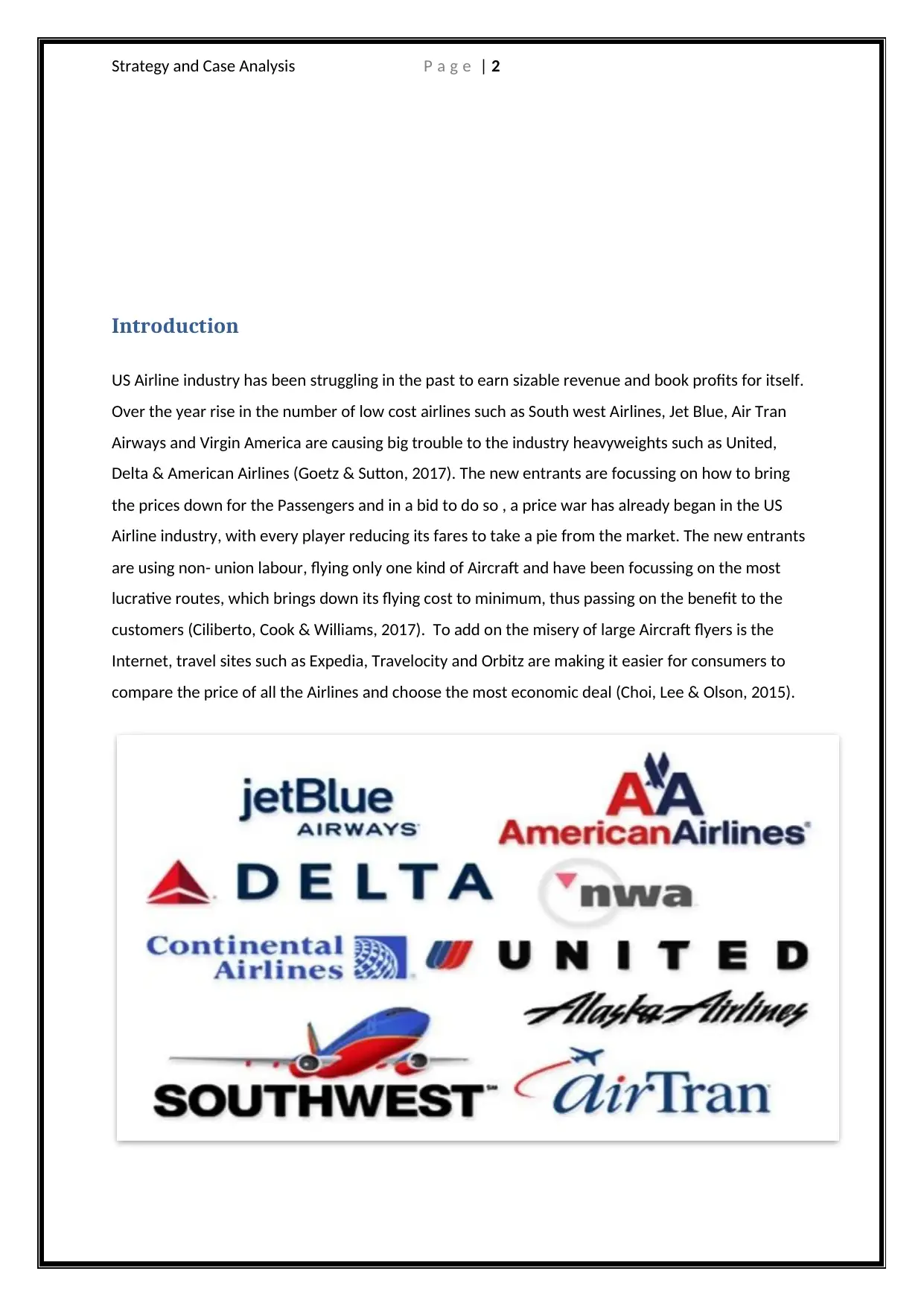
Strategy and Case Analysis P a g e | 2
Introduction
US Airline industry has been struggling in the past to earn sizable revenue and book profits for itself.
Over the year rise in the number of low cost airlines such as South west Airlines, Jet Blue, Air Tran
Airways and Virgin America are causing big trouble to the industry heavyweights such as United,
Delta & American Airlines (Goetz & Sutton, 2017). The new entrants are focussing on how to bring
the prices down for the Passengers and in a bid to do so , a price war has already began in the US
Airline industry, with every player reducing its fares to take a pie from the market. The new entrants
are using non- union labour, flying only one kind of Aircraft and have been focussing on the most
lucrative routes, which brings down its flying cost to minimum, thus passing on the benefit to the
customers (Ciliberto, Cook & Williams, 2017). To add on the misery of large Aircraft flyers is the
Internet, travel sites such as Expedia, Travelocity and Orbitz are making it easier for consumers to
compare the price of all the Airlines and choose the most economic deal (Choi, Lee & Olson, 2015).
Introduction
US Airline industry has been struggling in the past to earn sizable revenue and book profits for itself.
Over the year rise in the number of low cost airlines such as South west Airlines, Jet Blue, Air Tran
Airways and Virgin America are causing big trouble to the industry heavyweights such as United,
Delta & American Airlines (Goetz & Sutton, 2017). The new entrants are focussing on how to bring
the prices down for the Passengers and in a bid to do so , a price war has already began in the US
Airline industry, with every player reducing its fares to take a pie from the market. The new entrants
are using non- union labour, flying only one kind of Aircraft and have been focussing on the most
lucrative routes, which brings down its flying cost to minimum, thus passing on the benefit to the
customers (Ciliberto, Cook & Williams, 2017). To add on the misery of large Aircraft flyers is the
Internet, travel sites such as Expedia, Travelocity and Orbitz are making it easier for consumers to
compare the price of all the Airlines and choose the most economic deal (Choi, Lee & Olson, 2015).
⊘ This is a preview!⊘
Do you want full access?
Subscribe today to unlock all pages.

Trusted by 1+ million students worldwide
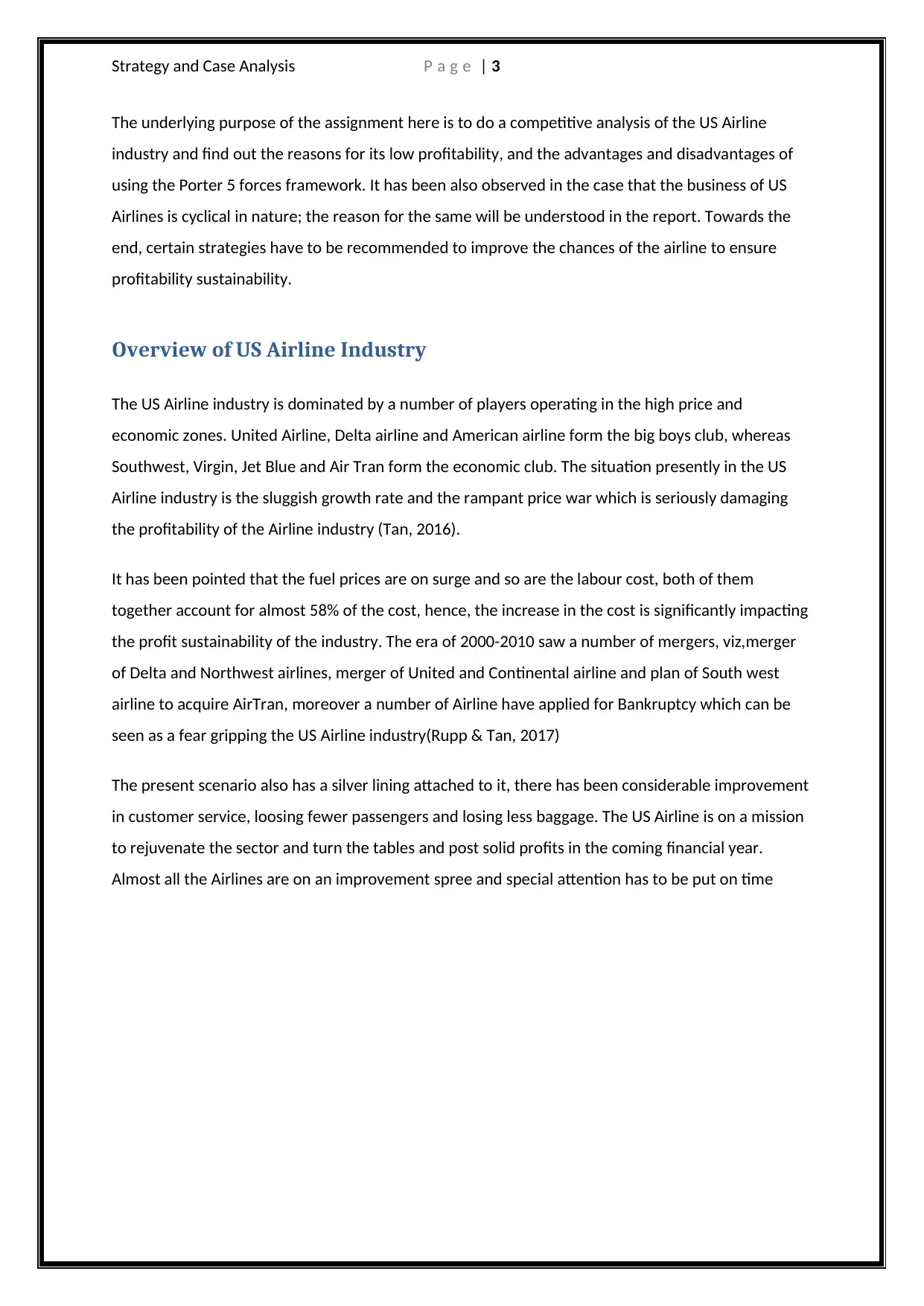
Strategy and Case Analysis P a g e | 3
The underlying purpose of the assignment here is to do a competitive analysis of the US Airline
industry and find out the reasons for its low profitability, and the advantages and disadvantages of
using the Porter 5 forces framework. It has been also observed in the case that the business of US
Airlines is cyclical in nature; the reason for the same will be understood in the report. Towards the
end, certain strategies have to be recommended to improve the chances of the airline to ensure
profitability sustainability.
Overview of US Airline Industry
The US Airline industry is dominated by a number of players operating in the high price and
economic zones. United Airline, Delta airline and American airline form the big boys club, whereas
Southwest, Virgin, Jet Blue and Air Tran form the economic club. The situation presently in the US
Airline industry is the sluggish growth rate and the rampant price war which is seriously damaging
the profitability of the Airline industry (Tan, 2016).
It has been pointed that the fuel prices are on surge and so are the labour cost, both of them
together account for almost 58% of the cost, hence, the increase in the cost is significantly impacting
the profit sustainability of the industry. The era of 2000-2010 saw a number of mergers, viz,merger
of Delta and Northwest airlines, merger of United and Continental airline and plan of South west
airline to acquire AirTran, moreover a number of Airline have applied for Bankruptcy which can be
seen as a fear gripping the US Airline industry(Rupp & Tan, 2017)
The present scenario also has a silver lining attached to it, there has been considerable improvement
in customer service, loosing fewer passengers and losing less baggage. The US Airline is on a mission
to rejuvenate the sector and turn the tables and post solid profits in the coming financial year.
Almost all the Airlines are on an improvement spree and special attention has to be put on time
The underlying purpose of the assignment here is to do a competitive analysis of the US Airline
industry and find out the reasons for its low profitability, and the advantages and disadvantages of
using the Porter 5 forces framework. It has been also observed in the case that the business of US
Airlines is cyclical in nature; the reason for the same will be understood in the report. Towards the
end, certain strategies have to be recommended to improve the chances of the airline to ensure
profitability sustainability.
Overview of US Airline Industry
The US Airline industry is dominated by a number of players operating in the high price and
economic zones. United Airline, Delta airline and American airline form the big boys club, whereas
Southwest, Virgin, Jet Blue and Air Tran form the economic club. The situation presently in the US
Airline industry is the sluggish growth rate and the rampant price war which is seriously damaging
the profitability of the Airline industry (Tan, 2016).
It has been pointed that the fuel prices are on surge and so are the labour cost, both of them
together account for almost 58% of the cost, hence, the increase in the cost is significantly impacting
the profit sustainability of the industry. The era of 2000-2010 saw a number of mergers, viz,merger
of Delta and Northwest airlines, merger of United and Continental airline and plan of South west
airline to acquire AirTran, moreover a number of Airline have applied for Bankruptcy which can be
seen as a fear gripping the US Airline industry(Rupp & Tan, 2017)
The present scenario also has a silver lining attached to it, there has been considerable improvement
in customer service, loosing fewer passengers and losing less baggage. The US Airline is on a mission
to rejuvenate the sector and turn the tables and post solid profits in the coming financial year.
Almost all the Airlines are on an improvement spree and special attention has to be put on time
Paraphrase This Document
Need a fresh take? Get an instant paraphrase of this document with our AI Paraphraser
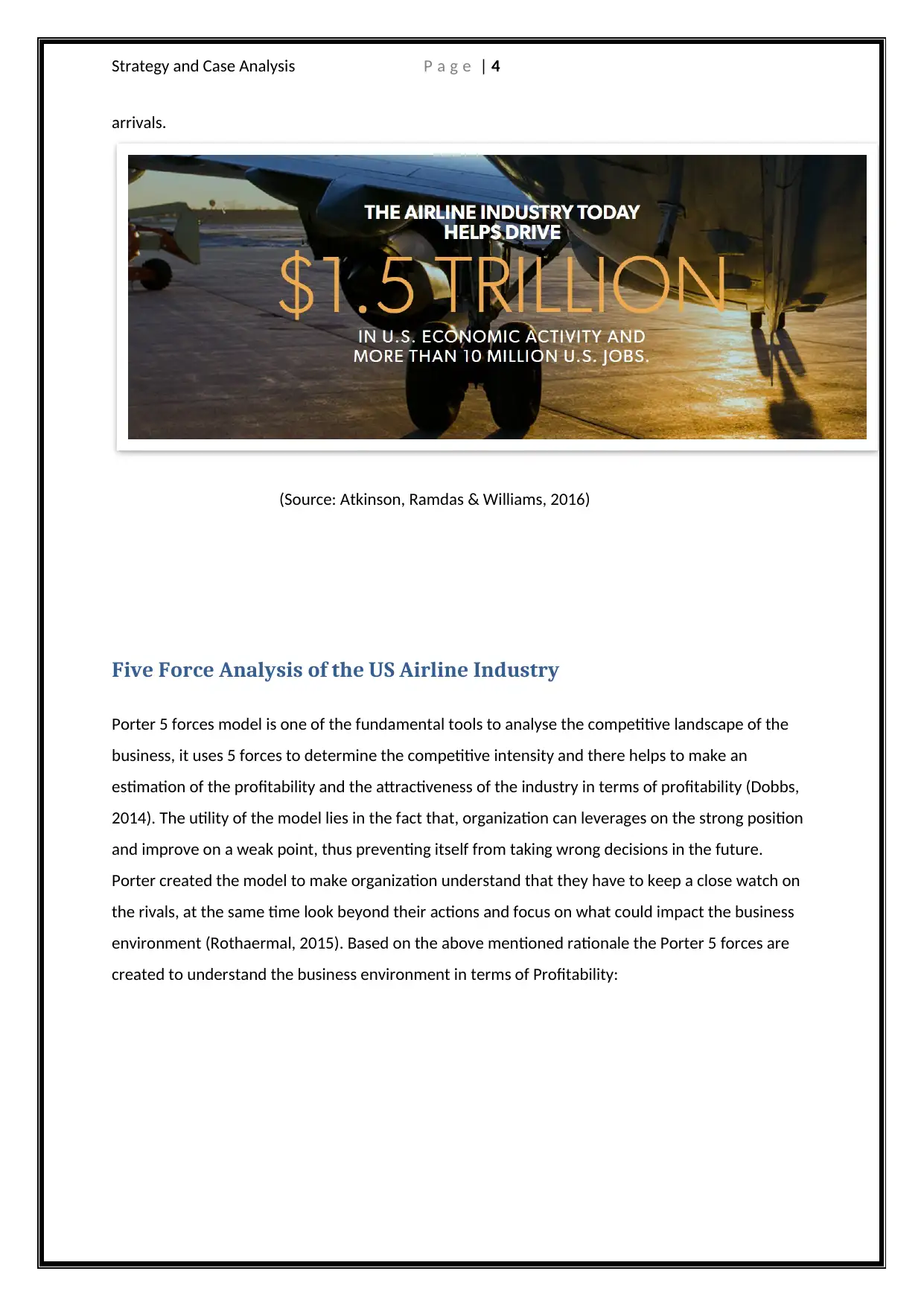
Strategy and Case Analysis P a g e | 4
arrivals.
(Source: Atkinson, Ramdas & Williams, 2016)
Five Force Analysis of the US Airline Industry
Porter 5 forces model is one of the fundamental tools to analyse the competitive landscape of the
business, it uses 5 forces to determine the competitive intensity and there helps to make an
estimation of the profitability and the attractiveness of the industry in terms of profitability (Dobbs,
2014). The utility of the model lies in the fact that, organization can leverages on the strong position
and improve on a weak point, thus preventing itself from taking wrong decisions in the future.
Porter created the model to make organization understand that they have to keep a close watch on
the rivals, at the same time look beyond their actions and focus on what could impact the business
environment (Rothaermal, 2015). Based on the above mentioned rationale the Porter 5 forces are
created to understand the business environment in terms of Profitability:
arrivals.
(Source: Atkinson, Ramdas & Williams, 2016)
Five Force Analysis of the US Airline Industry
Porter 5 forces model is one of the fundamental tools to analyse the competitive landscape of the
business, it uses 5 forces to determine the competitive intensity and there helps to make an
estimation of the profitability and the attractiveness of the industry in terms of profitability (Dobbs,
2014). The utility of the model lies in the fact that, organization can leverages on the strong position
and improve on a weak point, thus preventing itself from taking wrong decisions in the future.
Porter created the model to make organization understand that they have to keep a close watch on
the rivals, at the same time look beyond their actions and focus on what could impact the business
environment (Rothaermal, 2015). Based on the above mentioned rationale the Porter 5 forces are
created to understand the business environment in terms of Profitability:
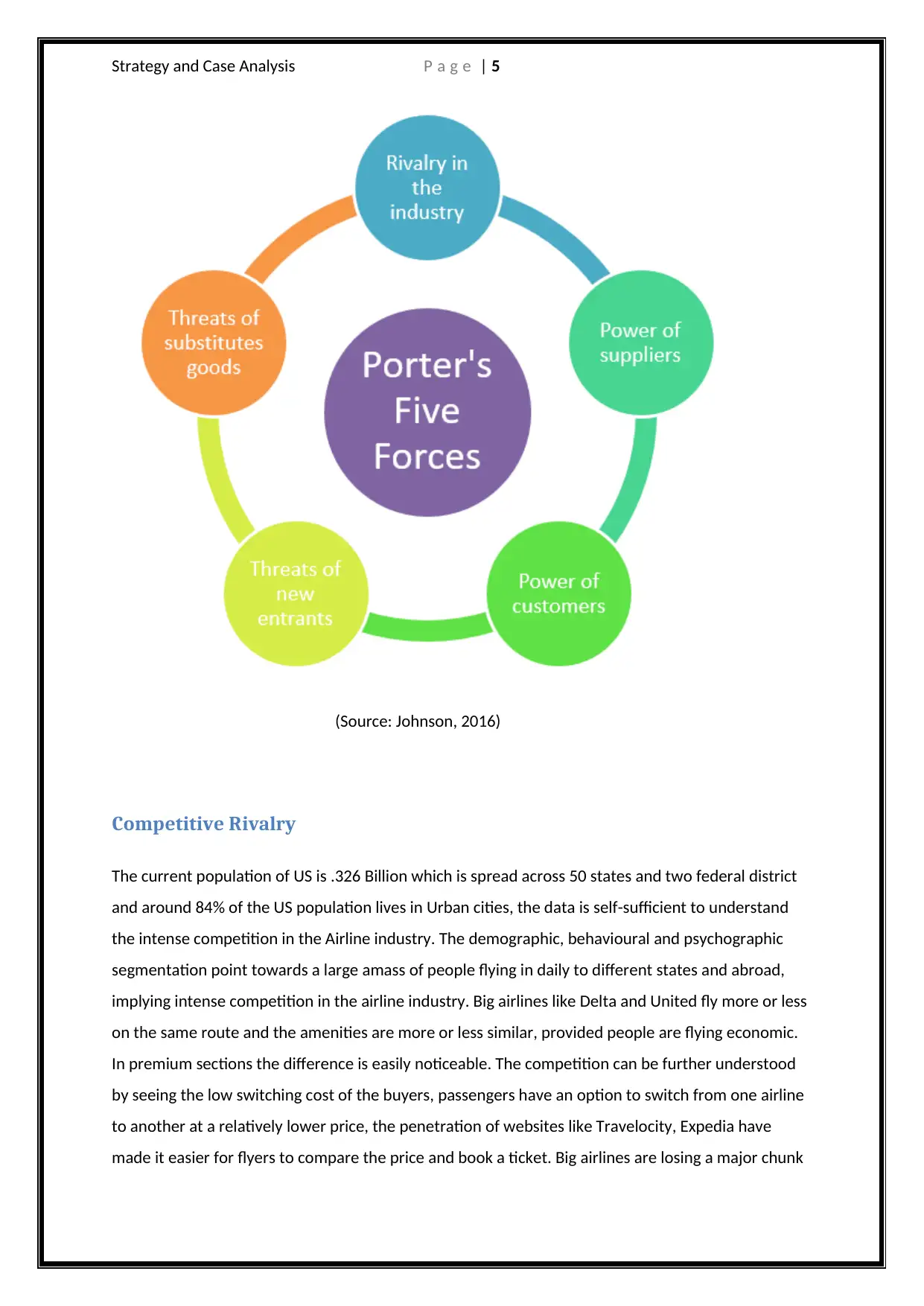
Strategy and Case Analysis P a g e | 5
(Source: Johnson, 2016)
Competitive Rivalry
The current population of US is .326 Billion which is spread across 50 states and two federal district
and around 84% of the US population lives in Urban cities, the data is self-sufficient to understand
the intense competition in the Airline industry. The demographic, behavioural and psychographic
segmentation point towards a large amass of people flying in daily to different states and abroad,
implying intense competition in the airline industry. Big airlines like Delta and United fly more or less
on the same route and the amenities are more or less similar, provided people are flying economic.
In premium sections the difference is easily noticeable. The competition can be further understood
by seeing the low switching cost of the buyers, passengers have an option to switch from one airline
to another at a relatively lower price, the penetration of websites like Travelocity, Expedia have
made it easier for flyers to compare the price and book a ticket. Big airlines are losing a major chunk
(Source: Johnson, 2016)
Competitive Rivalry
The current population of US is .326 Billion which is spread across 50 states and two federal district
and around 84% of the US population lives in Urban cities, the data is self-sufficient to understand
the intense competition in the Airline industry. The demographic, behavioural and psychographic
segmentation point towards a large amass of people flying in daily to different states and abroad,
implying intense competition in the airline industry. Big airlines like Delta and United fly more or less
on the same route and the amenities are more or less similar, provided people are flying economic.
In premium sections the difference is easily noticeable. The competition can be further understood
by seeing the low switching cost of the buyers, passengers have an option to switch from one airline
to another at a relatively lower price, the penetration of websites like Travelocity, Expedia have
made it easier for flyers to compare the price and book a ticket. Big airlines are losing a major chunk
⊘ This is a preview!⊘
Do you want full access?
Subscribe today to unlock all pages.

Trusted by 1+ million students worldwide
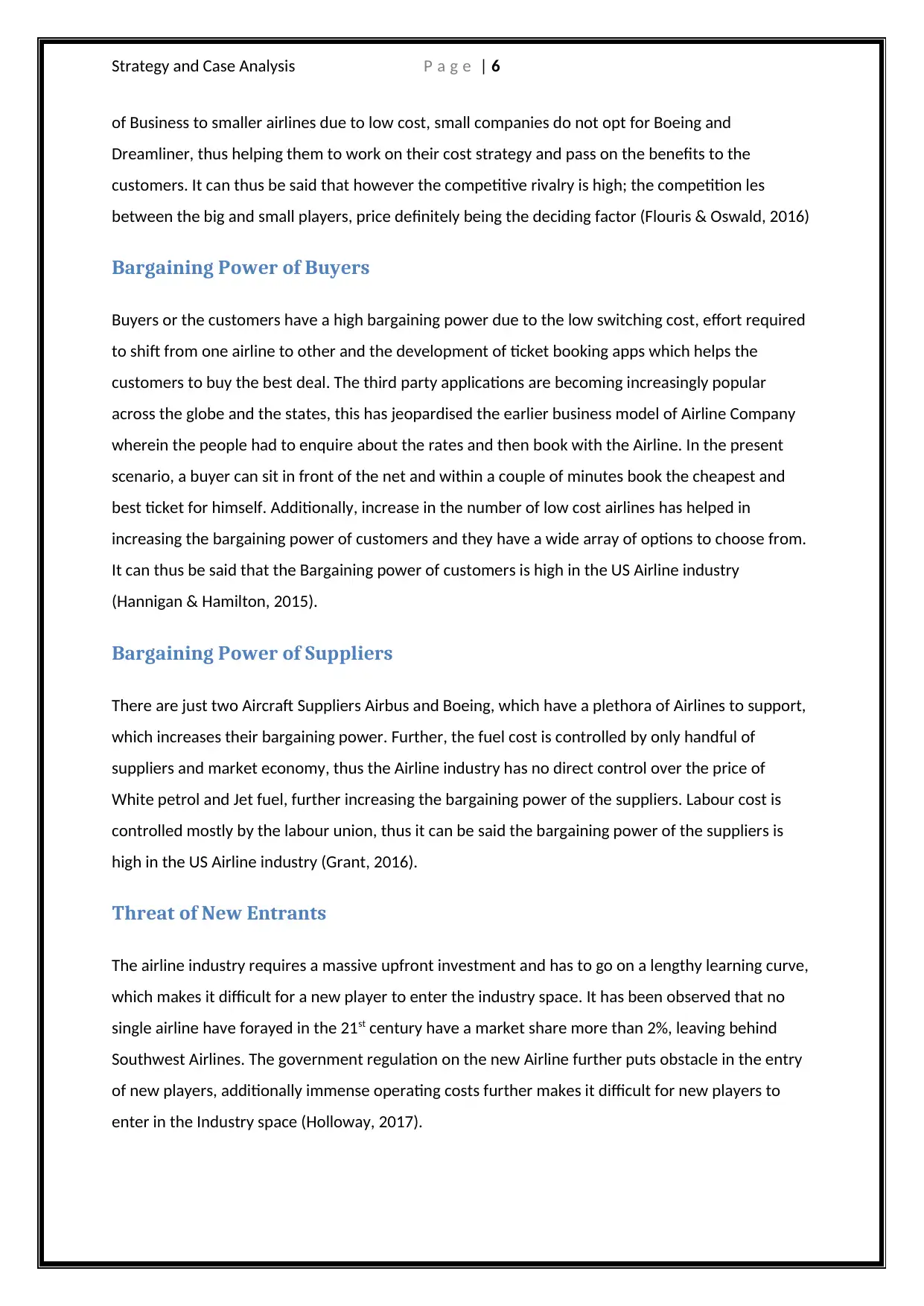
Strategy and Case Analysis P a g e | 6
of Business to smaller airlines due to low cost, small companies do not opt for Boeing and
Dreamliner, thus helping them to work on their cost strategy and pass on the benefits to the
customers. It can thus be said that however the competitive rivalry is high; the competition les
between the big and small players, price definitely being the deciding factor (Flouris & Oswald, 2016)
Bargaining Power of Buyers
Buyers or the customers have a high bargaining power due to the low switching cost, effort required
to shift from one airline to other and the development of ticket booking apps which helps the
customers to buy the best deal. The third party applications are becoming increasingly popular
across the globe and the states, this has jeopardised the earlier business model of Airline Company
wherein the people had to enquire about the rates and then book with the Airline. In the present
scenario, a buyer can sit in front of the net and within a couple of minutes book the cheapest and
best ticket for himself. Additionally, increase in the number of low cost airlines has helped in
increasing the bargaining power of customers and they have a wide array of options to choose from.
It can thus be said that the Bargaining power of customers is high in the US Airline industry
(Hannigan & Hamilton, 2015).
Bargaining Power of Suppliers
There are just two Aircraft Suppliers Airbus and Boeing, which have a plethora of Airlines to support,
which increases their bargaining power. Further, the fuel cost is controlled by only handful of
suppliers and market economy, thus the Airline industry has no direct control over the price of
White petrol and Jet fuel, further increasing the bargaining power of the suppliers. Labour cost is
controlled mostly by the labour union, thus it can be said the bargaining power of the suppliers is
high in the US Airline industry (Grant, 2016).
Threat of New Entrants
The airline industry requires a massive upfront investment and has to go on a lengthy learning curve,
which makes it difficult for a new player to enter the industry space. It has been observed that no
single airline have forayed in the 21st century have a market share more than 2%, leaving behind
Southwest Airlines. The government regulation on the new Airline further puts obstacle in the entry
of new players, additionally immense operating costs further makes it difficult for new players to
enter in the Industry space (Holloway, 2017).
of Business to smaller airlines due to low cost, small companies do not opt for Boeing and
Dreamliner, thus helping them to work on their cost strategy and pass on the benefits to the
customers. It can thus be said that however the competitive rivalry is high; the competition les
between the big and small players, price definitely being the deciding factor (Flouris & Oswald, 2016)
Bargaining Power of Buyers
Buyers or the customers have a high bargaining power due to the low switching cost, effort required
to shift from one airline to other and the development of ticket booking apps which helps the
customers to buy the best deal. The third party applications are becoming increasingly popular
across the globe and the states, this has jeopardised the earlier business model of Airline Company
wherein the people had to enquire about the rates and then book with the Airline. In the present
scenario, a buyer can sit in front of the net and within a couple of minutes book the cheapest and
best ticket for himself. Additionally, increase in the number of low cost airlines has helped in
increasing the bargaining power of customers and they have a wide array of options to choose from.
It can thus be said that the Bargaining power of customers is high in the US Airline industry
(Hannigan & Hamilton, 2015).
Bargaining Power of Suppliers
There are just two Aircraft Suppliers Airbus and Boeing, which have a plethora of Airlines to support,
which increases their bargaining power. Further, the fuel cost is controlled by only handful of
suppliers and market economy, thus the Airline industry has no direct control over the price of
White petrol and Jet fuel, further increasing the bargaining power of the suppliers. Labour cost is
controlled mostly by the labour union, thus it can be said the bargaining power of the suppliers is
high in the US Airline industry (Grant, 2016).
Threat of New Entrants
The airline industry requires a massive upfront investment and has to go on a lengthy learning curve,
which makes it difficult for a new player to enter the industry space. It has been observed that no
single airline have forayed in the 21st century have a market share more than 2%, leaving behind
Southwest Airlines. The government regulation on the new Airline further puts obstacle in the entry
of new players, additionally immense operating costs further makes it difficult for new players to
enter in the Industry space (Holloway, 2017).
Paraphrase This Document
Need a fresh take? Get an instant paraphrase of this document with our AI Paraphraser
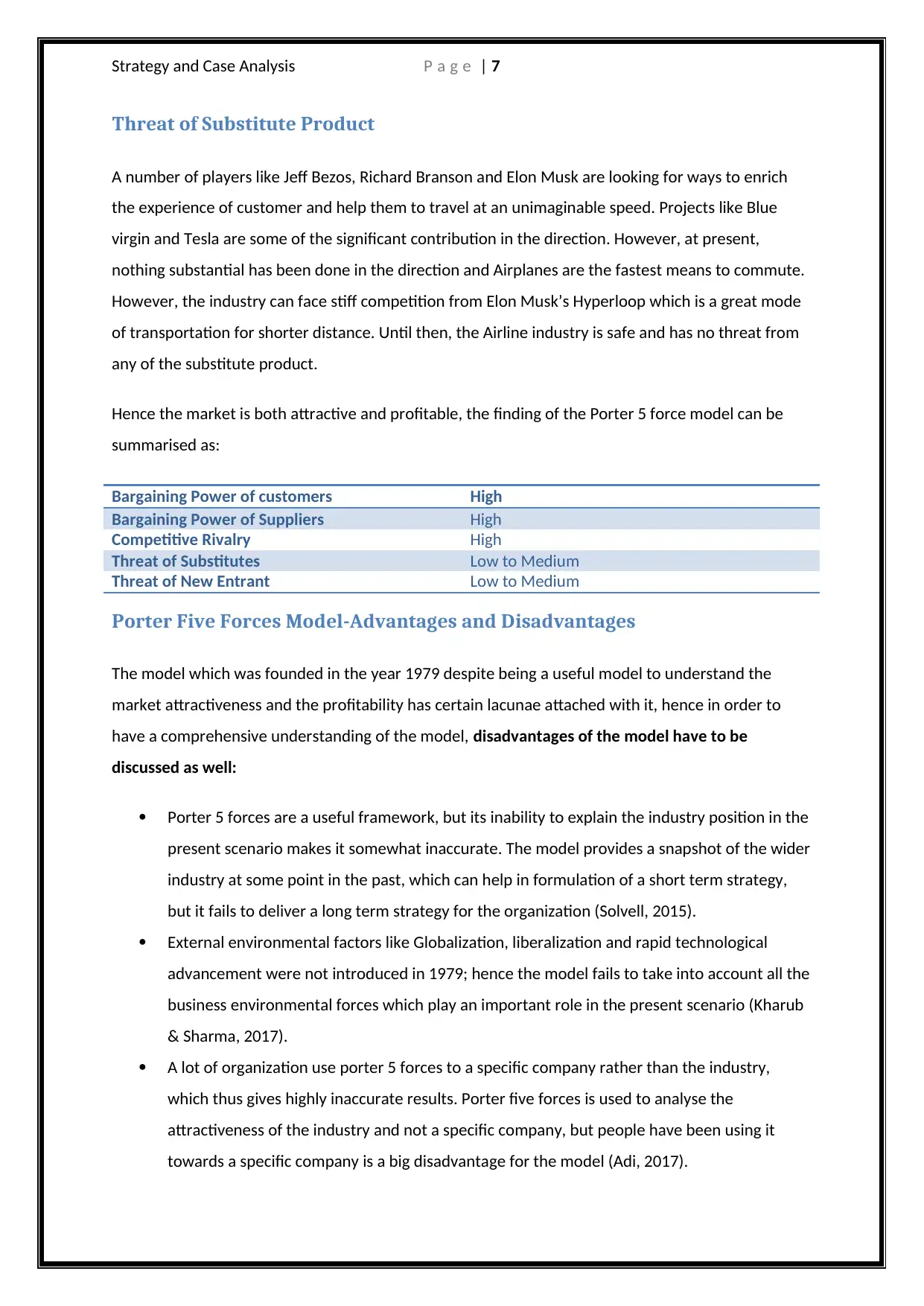
Strategy and Case Analysis P a g e | 7
Threat of Substitute Product
A number of players like Jeff Bezos, Richard Branson and Elon Musk are looking for ways to enrich
the experience of customer and help them to travel at an unimaginable speed. Projects like Blue
virgin and Tesla are some of the significant contribution in the direction. However, at present,
nothing substantial has been done in the direction and Airplanes are the fastest means to commute.
However, the industry can face stiff competition from Elon Musk’s Hyperloop which is a great mode
of transportation for shorter distance. Until then, the Airline industry is safe and has no threat from
any of the substitute product.
Hence the market is both attractive and profitable, the finding of the Porter 5 force model can be
summarised as:
Bargaining Power of customers High
Bargaining Power of Suppliers High
Competitive Rivalry High
Threat of Substitutes Low to Medium
Threat of New Entrant Low to Medium
Porter Five Forces Model-Advantages and Disadvantages
The model which was founded in the year 1979 despite being a useful model to understand the
market attractiveness and the profitability has certain lacunae attached with it, hence in order to
have a comprehensive understanding of the model, disadvantages of the model have to be
discussed as well:
Porter 5 forces are a useful framework, but its inability to explain the industry position in the
present scenario makes it somewhat inaccurate. The model provides a snapshot of the wider
industry at some point in the past, which can help in formulation of a short term strategy,
but it fails to deliver a long term strategy for the organization (Solvell, 2015).
External environmental factors like Globalization, liberalization and rapid technological
advancement were not introduced in 1979; hence the model fails to take into account all the
business environmental forces which play an important role in the present scenario (Kharub
& Sharma, 2017).
A lot of organization use porter 5 forces to a specific company rather than the industry,
which thus gives highly inaccurate results. Porter five forces is used to analyse the
attractiveness of the industry and not a specific company, but people have been using it
towards a specific company is a big disadvantage for the model (Adi, 2017).
Threat of Substitute Product
A number of players like Jeff Bezos, Richard Branson and Elon Musk are looking for ways to enrich
the experience of customer and help them to travel at an unimaginable speed. Projects like Blue
virgin and Tesla are some of the significant contribution in the direction. However, at present,
nothing substantial has been done in the direction and Airplanes are the fastest means to commute.
However, the industry can face stiff competition from Elon Musk’s Hyperloop which is a great mode
of transportation for shorter distance. Until then, the Airline industry is safe and has no threat from
any of the substitute product.
Hence the market is both attractive and profitable, the finding of the Porter 5 force model can be
summarised as:
Bargaining Power of customers High
Bargaining Power of Suppliers High
Competitive Rivalry High
Threat of Substitutes Low to Medium
Threat of New Entrant Low to Medium
Porter Five Forces Model-Advantages and Disadvantages
The model which was founded in the year 1979 despite being a useful model to understand the
market attractiveness and the profitability has certain lacunae attached with it, hence in order to
have a comprehensive understanding of the model, disadvantages of the model have to be
discussed as well:
Porter 5 forces are a useful framework, but its inability to explain the industry position in the
present scenario makes it somewhat inaccurate. The model provides a snapshot of the wider
industry at some point in the past, which can help in formulation of a short term strategy,
but it fails to deliver a long term strategy for the organization (Solvell, 2015).
External environmental factors like Globalization, liberalization and rapid technological
advancement were not introduced in 1979; hence the model fails to take into account all the
business environmental forces which play an important role in the present scenario (Kharub
& Sharma, 2017).
A lot of organization use porter 5 forces to a specific company rather than the industry,
which thus gives highly inaccurate results. Porter five forces is used to analyse the
attractiveness of the industry and not a specific company, but people have been using it
towards a specific company is a big disadvantage for the model (Adi, 2017).
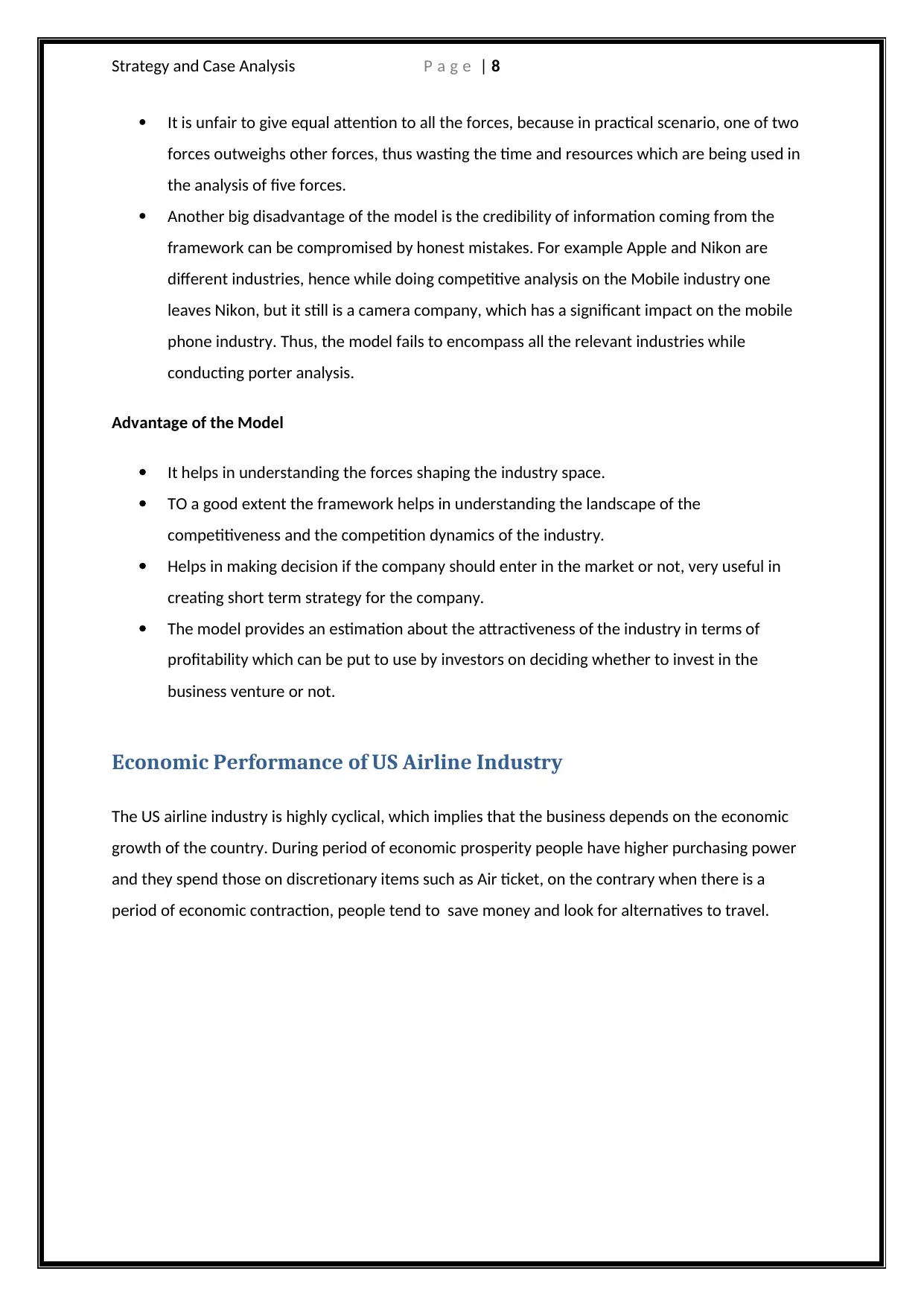
Strategy and Case Analysis P a g e | 8
It is unfair to give equal attention to all the forces, because in practical scenario, one of two
forces outweighs other forces, thus wasting the time and resources which are being used in
the analysis of five forces.
Another big disadvantage of the model is the credibility of information coming from the
framework can be compromised by honest mistakes. For example Apple and Nikon are
different industries, hence while doing competitive analysis on the Mobile industry one
leaves Nikon, but it still is a camera company, which has a significant impact on the mobile
phone industry. Thus, the model fails to encompass all the relevant industries while
conducting porter analysis.
Advantage of the Model
It helps in understanding the forces shaping the industry space.
TO a good extent the framework helps in understanding the landscape of the
competitiveness and the competition dynamics of the industry.
Helps in making decision if the company should enter in the market or not, very useful in
creating short term strategy for the company.
The model provides an estimation about the attractiveness of the industry in terms of
profitability which can be put to use by investors on deciding whether to invest in the
business venture or not.
Economic Performance of US Airline Industry
The US airline industry is highly cyclical, which implies that the business depends on the economic
growth of the country. During period of economic prosperity people have higher purchasing power
and they spend those on discretionary items such as Air ticket, on the contrary when there is a
period of economic contraction, people tend to save money and look for alternatives to travel.
It is unfair to give equal attention to all the forces, because in practical scenario, one of two
forces outweighs other forces, thus wasting the time and resources which are being used in
the analysis of five forces.
Another big disadvantage of the model is the credibility of information coming from the
framework can be compromised by honest mistakes. For example Apple and Nikon are
different industries, hence while doing competitive analysis on the Mobile industry one
leaves Nikon, but it still is a camera company, which has a significant impact on the mobile
phone industry. Thus, the model fails to encompass all the relevant industries while
conducting porter analysis.
Advantage of the Model
It helps in understanding the forces shaping the industry space.
TO a good extent the framework helps in understanding the landscape of the
competitiveness and the competition dynamics of the industry.
Helps in making decision if the company should enter in the market or not, very useful in
creating short term strategy for the company.
The model provides an estimation about the attractiveness of the industry in terms of
profitability which can be put to use by investors on deciding whether to invest in the
business venture or not.
Economic Performance of US Airline Industry
The US airline industry is highly cyclical, which implies that the business depends on the economic
growth of the country. During period of economic prosperity people have higher purchasing power
and they spend those on discretionary items such as Air ticket, on the contrary when there is a
period of economic contraction, people tend to save money and look for alternatives to travel.
⊘ This is a preview!⊘
Do you want full access?
Subscribe today to unlock all pages.

Trusted by 1+ million students worldwide
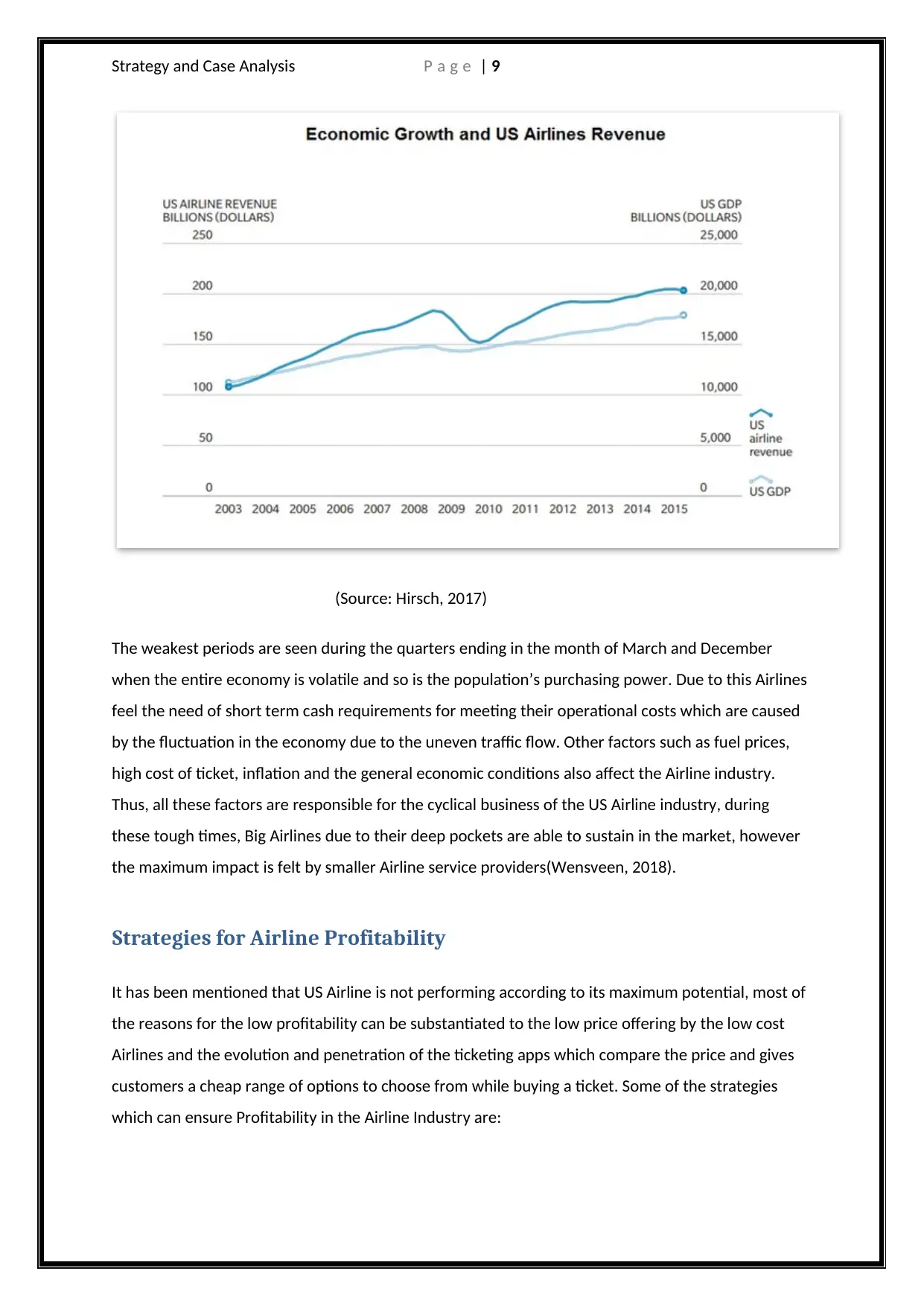
Strategy and Case Analysis P a g e | 9
(Source: Hirsch, 2017)
The weakest periods are seen during the quarters ending in the month of March and December
when the entire economy is volatile and so is the population’s purchasing power. Due to this Airlines
feel the need of short term cash requirements for meeting their operational costs which are caused
by the fluctuation in the economy due to the uneven traffic flow. Other factors such as fuel prices,
high cost of ticket, inflation and the general economic conditions also affect the Airline industry.
Thus, all these factors are responsible for the cyclical business of the US Airline industry, during
these tough times, Big Airlines due to their deep pockets are able to sustain in the market, however
the maximum impact is felt by smaller Airline service providers(Wensveen, 2018).
Strategies for Airline Profitability
It has been mentioned that US Airline is not performing according to its maximum potential, most of
the reasons for the low profitability can be substantiated to the low price offering by the low cost
Airlines and the evolution and penetration of the ticketing apps which compare the price and gives
customers a cheap range of options to choose from while buying a ticket. Some of the strategies
which can ensure Profitability in the Airline Industry are:
(Source: Hirsch, 2017)
The weakest periods are seen during the quarters ending in the month of March and December
when the entire economy is volatile and so is the population’s purchasing power. Due to this Airlines
feel the need of short term cash requirements for meeting their operational costs which are caused
by the fluctuation in the economy due to the uneven traffic flow. Other factors such as fuel prices,
high cost of ticket, inflation and the general economic conditions also affect the Airline industry.
Thus, all these factors are responsible for the cyclical business of the US Airline industry, during
these tough times, Big Airlines due to their deep pockets are able to sustain in the market, however
the maximum impact is felt by smaller Airline service providers(Wensveen, 2018).
Strategies for Airline Profitability
It has been mentioned that US Airline is not performing according to its maximum potential, most of
the reasons for the low profitability can be substantiated to the low price offering by the low cost
Airlines and the evolution and penetration of the ticketing apps which compare the price and gives
customers a cheap range of options to choose from while buying a ticket. Some of the strategies
which can ensure Profitability in the Airline Industry are:
Paraphrase This Document
Need a fresh take? Get an instant paraphrase of this document with our AI Paraphraser
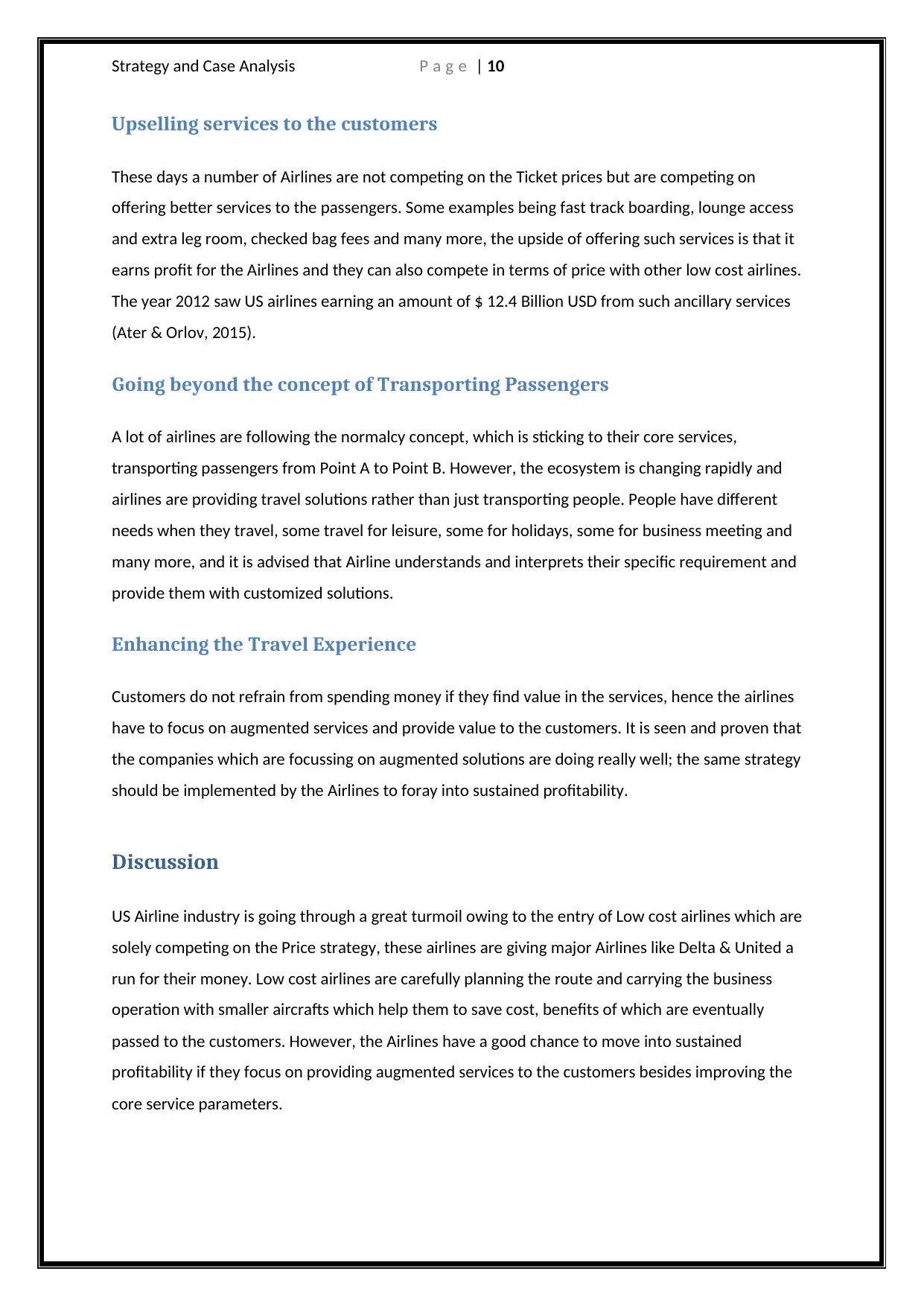
Strategy and Case Analysis P a g e | 10
Upselling services to the customers
These days a number of Airlines are not competing on the Ticket prices but are competing on
offering better services to the passengers. Some examples being fast track boarding, lounge access
and extra leg room, checked bag fees and many more, the upside of offering such services is that it
earns profit for the Airlines and they can also compete in terms of price with other low cost airlines.
The year 2012 saw US airlines earning an amount of $ 12.4 Billion USD from such ancillary services
(Ater & Orlov, 2015).
Going beyond the concept of Transporting Passengers
A lot of airlines are following the normalcy concept, which is sticking to their core services,
transporting passengers from Point A to Point B. However, the ecosystem is changing rapidly and
airlines are providing travel solutions rather than just transporting people. People have different
needs when they travel, some travel for leisure, some for holidays, some for business meeting and
many more, and it is advised that Airline understands and interprets their specific requirement and
provide them with customized solutions.
Enhancing the Travel Experience
Customers do not refrain from spending money if they find value in the services, hence the airlines
have to focus on augmented services and provide value to the customers. It is seen and proven that
the companies which are focussing on augmented solutions are doing really well; the same strategy
should be implemented by the Airlines to foray into sustained profitability.
Discussion
US Airline industry is going through a great turmoil owing to the entry of Low cost airlines which are
solely competing on the Price strategy, these airlines are giving major Airlines like Delta & United a
run for their money. Low cost airlines are carefully planning the route and carrying the business
operation with smaller aircrafts which help them to save cost, benefits of which are eventually
passed to the customers. However, the Airlines have a good chance to move into sustained
profitability if they focus on providing augmented services to the customers besides improving the
core service parameters.
Upselling services to the customers
These days a number of Airlines are not competing on the Ticket prices but are competing on
offering better services to the passengers. Some examples being fast track boarding, lounge access
and extra leg room, checked bag fees and many more, the upside of offering such services is that it
earns profit for the Airlines and they can also compete in terms of price with other low cost airlines.
The year 2012 saw US airlines earning an amount of $ 12.4 Billion USD from such ancillary services
(Ater & Orlov, 2015).
Going beyond the concept of Transporting Passengers
A lot of airlines are following the normalcy concept, which is sticking to their core services,
transporting passengers from Point A to Point B. However, the ecosystem is changing rapidly and
airlines are providing travel solutions rather than just transporting people. People have different
needs when they travel, some travel for leisure, some for holidays, some for business meeting and
many more, and it is advised that Airline understands and interprets their specific requirement and
provide them with customized solutions.
Enhancing the Travel Experience
Customers do not refrain from spending money if they find value in the services, hence the airlines
have to focus on augmented services and provide value to the customers. It is seen and proven that
the companies which are focussing on augmented solutions are doing really well; the same strategy
should be implemented by the Airlines to foray into sustained profitability.
Discussion
US Airline industry is going through a great turmoil owing to the entry of Low cost airlines which are
solely competing on the Price strategy, these airlines are giving major Airlines like Delta & United a
run for their money. Low cost airlines are carefully planning the route and carrying the business
operation with smaller aircrafts which help them to save cost, benefits of which are eventually
passed to the customers. However, the Airlines have a good chance to move into sustained
profitability if they focus on providing augmented services to the customers besides improving the
core service parameters.
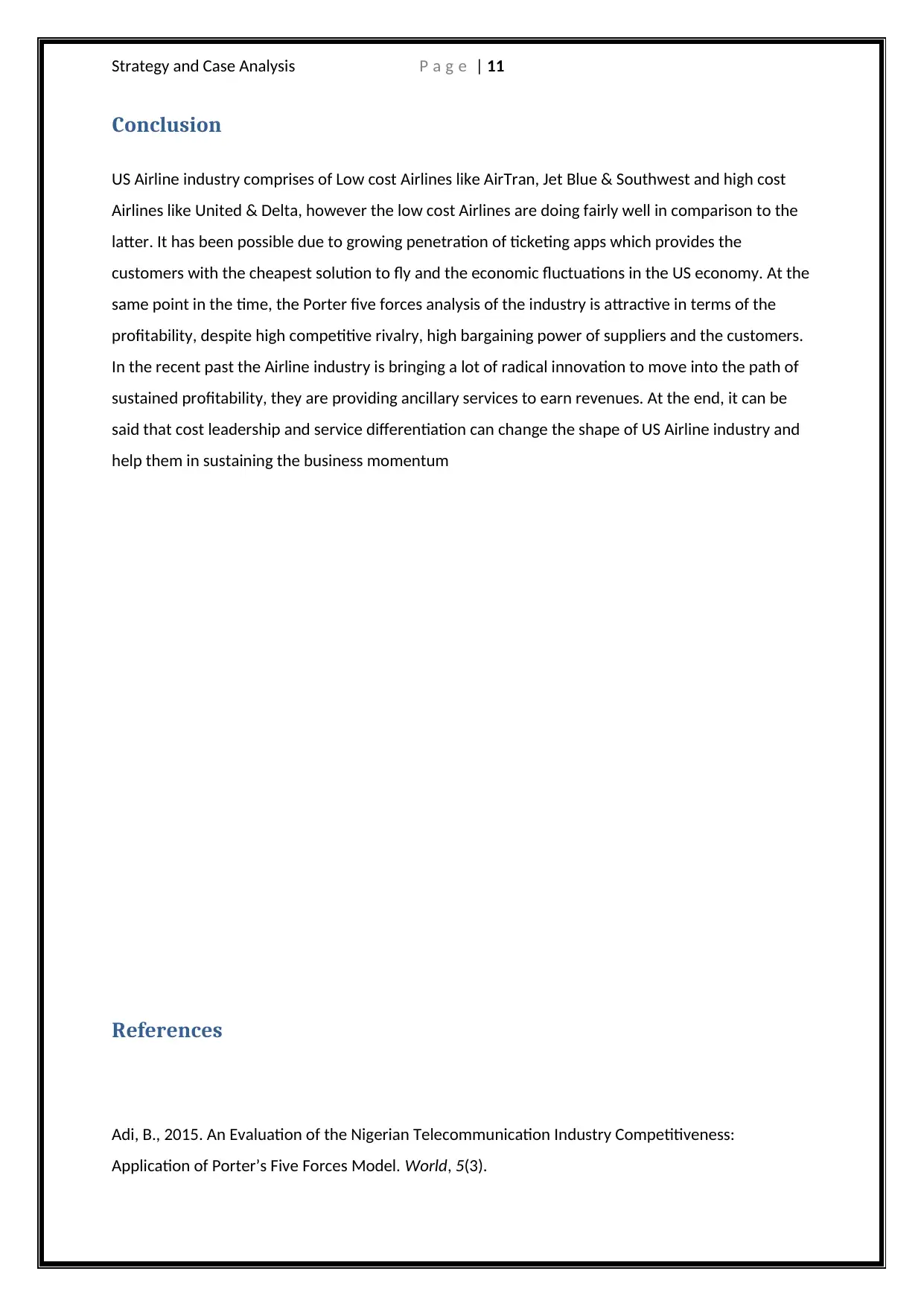
Strategy and Case Analysis P a g e | 11
Conclusion
US Airline industry comprises of Low cost Airlines like AirTran, Jet Blue & Southwest and high cost
Airlines like United & Delta, however the low cost Airlines are doing fairly well in comparison to the
latter. It has been possible due to growing penetration of ticketing apps which provides the
customers with the cheapest solution to fly and the economic fluctuations in the US economy. At the
same point in the time, the Porter five forces analysis of the industry is attractive in terms of the
profitability, despite high competitive rivalry, high bargaining power of suppliers and the customers.
In the recent past the Airline industry is bringing a lot of radical innovation to move into the path of
sustained profitability, they are providing ancillary services to earn revenues. At the end, it can be
said that cost leadership and service differentiation can change the shape of US Airline industry and
help them in sustaining the business momentum
References
Adi, B., 2015. An Evaluation of the Nigerian Telecommunication Industry Competitiveness:
Application of Porter’s Five Forces Model. World, 5(3).
Conclusion
US Airline industry comprises of Low cost Airlines like AirTran, Jet Blue & Southwest and high cost
Airlines like United & Delta, however the low cost Airlines are doing fairly well in comparison to the
latter. It has been possible due to growing penetration of ticketing apps which provides the
customers with the cheapest solution to fly and the economic fluctuations in the US economy. At the
same point in the time, the Porter five forces analysis of the industry is attractive in terms of the
profitability, despite high competitive rivalry, high bargaining power of suppliers and the customers.
In the recent past the Airline industry is bringing a lot of radical innovation to move into the path of
sustained profitability, they are providing ancillary services to earn revenues. At the end, it can be
said that cost leadership and service differentiation can change the shape of US Airline industry and
help them in sustaining the business momentum
References
Adi, B., 2015. An Evaluation of the Nigerian Telecommunication Industry Competitiveness:
Application of Porter’s Five Forces Model. World, 5(3).
⊘ This is a preview!⊘
Do you want full access?
Subscribe today to unlock all pages.

Trusted by 1+ million students worldwide
1 out of 14
Related Documents
Your All-in-One AI-Powered Toolkit for Academic Success.
+13062052269
info@desklib.com
Available 24*7 on WhatsApp / Email
![[object Object]](/_next/static/media/star-bottom.7253800d.svg)
Unlock your academic potential
Copyright © 2020–2025 A2Z Services. All Rights Reserved. Developed and managed by ZUCOL.





